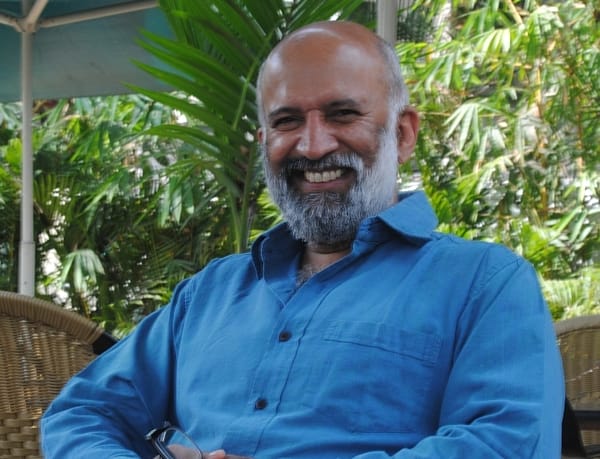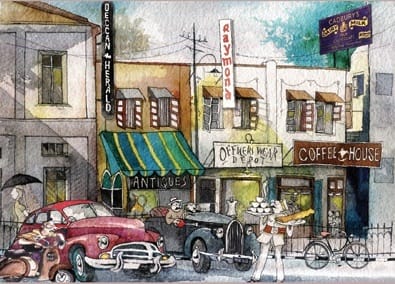A Bangalore of leisurely afternoon siestas, trees in abundance, monkey tops adorning grand bungalows, joyous celebrations unrestrained through the night and cycle rickshaws that got you about town. How do you celebrate the best years of your life? Artist Paul Fernandes does it with a series of 50 paintings that relive vibrant Bengaluru of the 70s. While the series currently reflects life in the Cantonment areas, Paul hopes to extend this in the coming months. aPaulogy opened on 21 December 2011.

Paul Fernandes. Pic: Christina Daniels
The paintings themselves are not easily classified into any genre, as humorous caricatures meet experienced history and artistic documentation in watercolours. The end result is a collection reflective of Paul’s characteristic artistic style. All cities need artists to bring their traditions and little idiosyncrasies alive. If Goa and Mumbai had Mario Miranda, Bengaluru has Paul Fernandes.
While he has been amongst Bengaluru’s best known illustrators and cartoonists, in the past Paul’s work has been closely associated with his illustration of On a High Note’ – a slightly inebriated introduction to Western music; Peter Colaco’s ‘Bangalore’; and ‘Shine Board Arts’ – an authentic collection of signs of the times in India. His recent work also includes the poster mural ‘Bang Bang Bangalore’; Sillycon City; The Ambassador of India; and a series of Shine Board’ posters.
Paul says of the spirit that guides his work, "It gives me great happiness to smile when I am working. Anything too serious just doesn’t flow onto paper." But there’s no self-indulgence at work in his art. As Paul adds, "It’s a nice way to approach a serious topic. You can’t simply depict Bengaluru changing in a text book fashion."
Most of these paintings were drawn at leisure, with no specific purpose in mind. But they have now come together as an exhibition series at Paul’s studio aPaulogy. He explains, "I wanted to show these drawings to people who remember that time of Bangalore and get them to feel nostalgic about it."
Paul expects the current exhibition to continue for a year before the paintings will also be brought together in a book remembering memories of Bengaluru. In the future, Paul’s hopes to move to documenting economies on the street. Like his previous work, his perspective will remain on a lighter vein.

Paul Fernandes’s work. Pic: Christina Daniels.
So how did Bengaluru begin to emerge as an important theme in Paul’s work? He says, "I have dealt with things I know and care about. There are just a couple of places I would like to live in. They are Bengaluru, San Francisco and possibly a remote village. In any of these places, I would have felt equally passionate about what’s happening around me."
Change is a constant theme in Bengaluru’s landscape at the turn of the new millennium. Even Richard’s Park, where aPaulogy is located, had just 12 houses in the 70s. Paul recollects, "Children who grew in those houses climbed trees and raided their neighbours’ compounds. Everyone knew each other." Looking back at Bengaluru in the 70s Paul reminisces, "most people cycled or walked, and you always had time to wish your friends and neighbours. It was a polite, courteous and happy life."
It is this spirit that pervades Paul’s art too, even as old motifs and landmarks resurface easily. Here we are reminded of a simpler Bengaluru where riding a bicycle without a kerosene oil lamp was the day’s biggest traffic offence, institutions like Dewars dotted the landscape and dating went under the name of "getting friendly" at Thom’s. At least here, it’s a far cry from the fumes and chaos of new Bengaluru.
So how does the artist in him come to terms with the rapid transformation? Paul believes, "The changes are skin deep. If you go down any street and look beyond the first row of monstrous new buildings, it’s still the beautiful old Bengaluru. We are the same people."
But Paul agrees that little has been done to preserve the city’s heritage. "I don’t think anything should be done to get the past back either. But what’s being done should be created with structure and grace." While conceding that spacious bungalows for just five people may now be impractical, he believes that buildings should relate to their surroundings. Paul adds, "We’ve got to work with change, while controlling it."
And till our city planners and architects recollect those old principles of structure, grace and working with change, Paul’s gallery of curious memories remains a gentle reminder to a paradise lost that perhaps may still be regained.
aPaulogy is located at 15 Clarke Road (Opp. Au Bon Pain) Richards Park Entrance, Richards Town, Bangalore – 560 005. The studio is open between 11 am to 7.30 pm from Monday to Saturday.